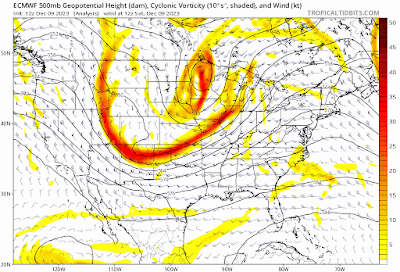There is high confidence in a significant pattern change happening for North America, bringing a much colder airmass to the central and eastern US. In this thread, I will explain the specifics of why.
Firstly, the storm on the 28th will bring in the Arctic airmass after it moves out, which will be coming from Siberia due to the -WPO/-EPO. This is accompanied by ridging in western NA building due to an equatorial jet extension.
Next, let's focus more on Asia. An +EAMT event is predicted, which indicates a jet extension, and we can see this from the AAM spiking. This jet will also be more equatorial rather than poleward, so as a result of this, the jet will speed up into the north-central Pacific, with lower heights expected downstream from Japan to north of HI.
Due to the equatorial shift -> extension, not only is downstream ridging built over western North America, but blocking is set up north of the jet across the far north NPAC, forcing strong blocking over the high latitudes; Siberia/Asia to Alaska/N America(-WPO/-EPO), which forces an arctic airmass into the mid-latitudes of North America. Furthermore, because of the western ridge, it specifically goes into the central-eastern US.
Looking at the MJO, the MJO is very weak and slow-moving over the MC, showing that teleconnections are overriding the MJO. The jet is in the right place; with the +AAM being strong enough to extend the jet to a favorable position but not strong enough to overextend the jet. This, along with the slow-moving and weak MJO is good for maintaining this pattern in general, though I'd expect a small reset at some point as we reload again(mid December?).
This pattern is also going to cool the warm pool off of Japan and warm the GOA and West Coast, so we should expect to see the PDO rise. It will not flip this winter but we should see some significant rises given how sustained this pattern looks to be.
As for the NATL, although we have an -NAO, I don't expect anything sustained in response to the wave reflection in the NPAC(-EPO); it will probably be replaced by a Hudson Bay vortex. In my opinion, while we probably will have -NAO at times in this pattern, it will be happening because of wavebreaking/intensifying 50/50 lows - so more shortlived. Generally, I'd favor a neutral NAO for the upcoming time period, but I'd assume after the next reload that we start seeing more HB vortex.
After the Arctic airmass moves in, the eastern US will have significantly well below normal temperatures. A tall western ridge will create split flow, with the NS going through the northern portion of the ridge and the southern stream undercutting the ridge. However, the first part the pattern will be cold and dry as the baroclinic zone gets suppressed well to the south and there isn't any room for NS waves to amplify or southern stream disturbances to bring moisture up. This holds from the very start to ~Dec 5-7, but this will set a very favorable and cold antecedent airmass in place for when the trough lets up a bit and there's more legroom for waves to properly amplify, with a taller/stronger +PNA that looks to connect more with the WPO/EPO ridge, providing a more amped pattern. I'd say Dec 5 to the start of mid-Dec is the most viable time period for snow in the mid-Atlantic/Northeast.
The Alaskan ridge will retrograde westward into Siberia eventually, which will retract the jet(reload), but with the continuing +AAM, I doubt we switch to a canonical Nina pattern rather than just a small reset. Thus, the Aleutian trough will back away eventually as it loses momentum from this week's +EAMT/jet extension, but I'd assume we get the AK ridge to move poleward again with another small jet extension that brings cold air eastward again. MJO will enter WPAC which will regenerate westerly momentum again.
Overall, a cold pattern will take place for the central-eastern US, and will have legs for most of December due to the favorable atmospheric conditions in place.
.png)
.png)






.png)

.png)
.png)
.png)
.png)


.png)



.png)




.png)








.png)

















